
A toradar is a South Asian matchlock primarily found in the Mughal Empire, dating from the 16th century. It was a preferred firearm in India well until the mid-19th century because of its simple and cheap design.

A toradar is a South Asian matchlock primarily found in the Mughal Empire, dating from the 16th century. It was a preferred firearm in India well until the mid-19th century because of its simple and cheap design.
When the Portuguese reached India in 1498, they brought with them firearms, among them the matchlock musket. However, expert armorers were already plentiful in India, and native craftsmen began to copy the weapons and adapting them for their own needs. Most of these craftsmen started to apply a style of decoration that normally would be applied to their traditional weapon. Soon a distinctive local style evolved, and the toradar was invented in the Indian subcontinent. [1]
Toradar matchlock remained to be the preferred firearms mechanism well until about 1830. Part of the reason why the matchlocks were still more popular than the wheellocks and flintlocks was because the matchlocks were easier and cheaper to produce. [2] Toradar was sometimes used as a hunting gun.
A toradar is basically an Indian matchlock. They were found mostly in the Mughal-influenced Northern and Central India. Two types of toradar exist: one has a very slim, from 3 feet (91 cm) to 6 feet (180 cm) long, straight stock with pentagonal-shaped section, and a light barrel; the other type is always between 5 feet (150 cm) to 6 feet (180 cm) long, has a curved stock with diamond-shaped section and a very heavy barrel, much enlarged at the breech. Both have the regular Indian type of lock, which is covered with a pan cover that usually swings on a pin. The iron side plates which reinforce each side of the stock extend for some distance on each side of the lock. [3]
The barrel is usually fastened to the stock by wire band or leather thongs which frequently pass over silver saddles on the barrel. The rear sight of the first type have ogival shape, or an open V, while the second usually has a very large open rear sight. Both types' muzzles are generally fastened with moulded ring. The front sight are made very long so as to show above them. This front sights were often shaped into figurative forms e.g. the nose of a man, or shaped like tiger's head. [4] Some toradar have square-shaped barrel, even with square bores. Both types generally have a clevis for a sling strap and some have two. [3]
Compared with the European matchlocks, the stock of a toradar has a more simple shape than the fish-tail shaped butt of the European matchlock. The stock is also too small to be placed against the shoulder, so the Indian toradar were normally held beneath the arm. [5]
A toradar used for sporting gun had painting of hunting figures, e.g. birds, other animals, and landscapes.

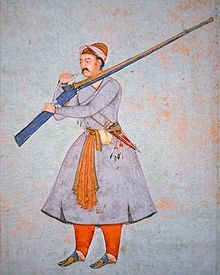
Decoration of a toradar reflects the local culture where the toradar is created. For the toradar, craftsmen produced some very complex ornate art from ivory bone or precious metal inlays on the barrels and the stocks. 16th century paintings, especially in the paintings during Mughal emperor Akbar's time, depict a few soldiers using matchlocks. Akbar's reign saw the rise of the tufang . [6] Up to the middle of the 18th century, the weapon was looked on with less favour than the bow and arrow. 17th century Mughal emperor Shah Jahan was depicted holding a matchlock with floral decoration. [7] A toradar from 18th-century Mysore, in the southern Indian state of Karnataka is exquisitely decorated with incised flowers and foliage. The decorations are entirely gilded. The incised side plates are made of iron. Animal figures are thoroughly represented in the toradar; the match holder of toradar usually has a serpentine naga-like shape, figures of tiger are impressed in the trigger of the Mysore toradar. A 19th-century toradar from Narwar has a tiger's head shaped around the muzzle. [8]

A firearm is any type of gun that uses an explosive charge and is designed to be readily carried and used by an individual. The term is legally defined further in different countries.

Flintlock is a general term for any firearm that uses a flint-striking ignition mechanism, the first of which appeared in Western Europe in the early 16th century. The term may also apply to a particular form of the mechanism itself, also known as the true flintlock, that was introduced in the early 17th century, and gradually replaced earlier firearm-ignition technologies, such as the matchlock, the wheellock, and the earlier flintlock mechanisms such as the snaplock and snaphaunce.

A matchlock or firelock is a historical type of firearm wherein the gunpowder is ignited by a burning piece of flammable cord or twine that is in contact with the gunpowder through a mechanism that the musketeer activates by pulling a lever or trigger with their finger. This firing mechanism was an improvement over the hand cannon, which lacked a trigger and required the musketeer or an assistant to apply a match directly to the gunpowder by hand. The matchlock mechanism allowed the musketeer to apply the match himself without losing his concentration.

The wall gun or wall piece was a type of smoothbore firearm used in the 16th through 18th centuries by defending forces to break the advance of enemy troops. Essentially, it was a scaled-up version of the army's standard infantry musket, operating under the same principles, but with a bore of up to one-inch (25.4 mm) calibre. These weapons filled a gap in firepower between the musket and the lightest artillery pieces, such as the swivel gun. This sort of weapon may also be found described as a rampart gun, hackbut or amusette, a name originally given to early medieval hand cannon.

A gunsmith is a person who repairs, modifies, designs, or builds guns. The occupation differs from an armorer, who usually replaces only worn parts in standard firearms. Gunsmiths do modifications and changes to a firearm that may require a very high level of craftsmanship, requiring the skills of a top-level machinist, a very skilled woodworker, and even an engineer. Gunsmiths perform factory-level repairs and renovations to restore well-used or deteriorated firearms to new condition. They may make alterations to adapt sporting guns to better fit the individual shooter that may require extensive modifications to the firearm's stocks and metal parts. Repairs and redesigns may require fabrication and fitting of unavailable parts and assemblies constructed by smiths themselves. Gunsmiths may also renew metal finishes or apply decorative carvings or engravings to guns. Many gun shops offer gunsmithing service on the premises.
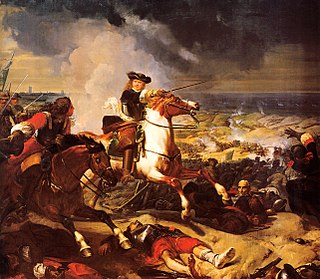
Early modern warfare is the era of warfare following medieval warfare. It is associated with the start of the widespread use of gunpowder and the development of suitable weapons to use the explosive, including artillery and firearms; for this reason the era is also referred to as the age of gunpowder warfare. This entire period is contained within the Age of Sail, which characteristic dominated the era's naval tactics, including the use of gunpowder in naval artillery.
A gunstock or often simply stock, the back portion of which is also known as a shoulder stock, a buttstock, or simply a butt, is a part of a long gun that provides structural support, to which the barrel, action, and firing mechanism are attached. The stock also provides a means for the shooter to firmly brace the gun and easily aim with stability by being held against the user's shoulder when shooting the gun, and helps to counter muzzle rise by transmitting recoil straight into the shooter's body.

The Enfield Pattern 1853 rifle-musket was a .577 calibre Minié-type muzzle-loading rifled musket, used by the British Empire from 1853 to 1867; after which many were replaced in service by the cartridge-loaded Snider–Enfield rifle.

A handgun is a firearm designed to be usable with only one hand. It is distinguished from a long gun which needs to be held by both hands and braced against the shoulder. Handguns have shorter effective ranges compared to long guns, and are much harder to shoot accurately. While most early handguns are single-shot pistols, the two most common types of handguns used in modern times are revolvers and semi-automatic pistols, although other handguns such as derringers and machine pistols also see infrequent usage.
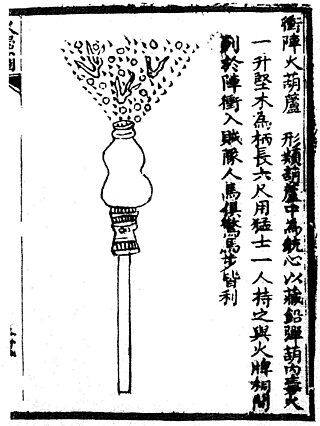
The history of firearms begins in 10th-century China, when tubes containing gunpowder and pellet projectiles were mounted on spears to make portable fire lances, operable by one person. This was later used effectively as a shock weapon in the Siege of De'an in 1132. In the 13th century, fire lance barrels were replaced with metal tubes and transformed into metal-barreled hand cannons. The technology gradually spread throughout Eurasia during the 14th century and evolved into flintlocks, blunderbusses, and other variants. The 19th and 20th centuries saw an acceleration in this evolution, with the introduction of the magazine, belt-fed weapons, metal cartridges, and the automatic firearm. Older firearms typically used black powder as a propellant, but modern firearms use smokeless powder or other propellants. Most modern firearms have rifled barrels.
The following are terms related to firearms and ammunition topics.

A gun is a device designed to propel a projectile using pressure or explosive force. The projectiles are typically solid, but can also be pressurized liquid, or gas. Solid projectiles may be free-flying or tethered. A large-caliber gun is also called a cannon.
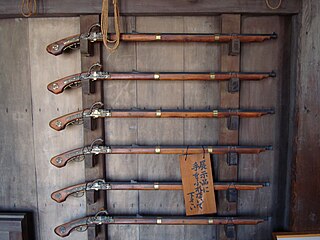
Firearms were introduced to Japan in the 13th century during the first Mongol invasion, referred to as teppō. Portuguese firearms were introduced in 1543, and intense development followed, with strong local manufacture during the period of conflicts of the late 16th century. Hōjutsu, the art of gunnery, is the Japanese martial art dedicated to firearms usage.
Mughal artillery included a variety of cannons, rockets, and mines employed by the Mughal Empire. This gunpowder technology played an important role in the formation and expansion of the empire. In the opening lines of Abul Fazl's famous text Ain-i-Akbari, he claims that "except for the Mediterranean/Ottoman territories (Rumistan), in no other place was gunpowder artillery available in such abundance as in the Mughal Empire." Thereby subtly referring to the superiority of the empire's artillery over the Safavids and Shaibanids. During the reign of the first three Timurid rulers of India—Babur, Humayun, and Akbar—gunpowder artillery had "emerged as an important equipage of war, contributing significantly to the establishment of a highly centralized state structure under Akbar and to the consolidation of Mughal rule in the conquered territories."

Mughal weapons significantly evolved during the ruling periods of its various rulers. During its conquests throughout the centuries, the military of the Mughal Empire used a variety of weapons including swords, bows and arrows, horses, camels, elephants, some of the world's largest cannons, muskets and flintlock blunderbusses.

Mughal clothing refers to clothing worn by the Mughals in the 16th, 17th and 18th centuries throughout the extent of their empire. Much of them were already being used in the past centuries before their arrival in Indian subcontinent. It was characterized by luxurious styles and was made with muslin, silk, velvet and brocade. Elaborate patterns including dots, checks, and waves were used with colors from various dyes including cochineal, sulfate of iron, sulfate of copper, and sulfate of antimony were used.

The piha kaetta, also sometimes called 'the Kandyan knife', is a knife or dagger native to the island of Sri Lanka. A typical piha kaetta has a straight-backed blade combined with a drop-point and a curved cutting edge. Many of the finest piha kaetta knives were produced in royal workshops, show very high levels of craftsmanship, and were given to courtiers and the nobility as status symbols.
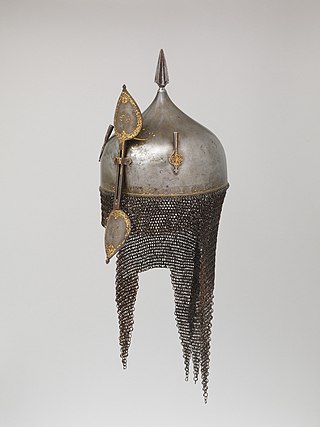
Kulah Khuds were used in ancient western Asia for battle and as decorative head pieces.
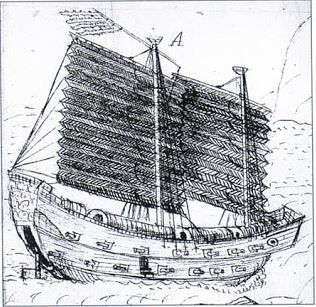
The Ming dynasty continued to improve on gunpowder weapons from the Yuan and Song dynasties as part of its military. During the early Ming period larger and more cannons were used in warfare. In the early 16th century Turkish and Portuguese breech-loading swivel guns and matchlock firearms were incorporated into the Ming arsenal. In the 17th century Dutch culverin were incorporated as well and became known as hongyipao. At the very end of the Ming dynasty, around 1642, Chinese combined European cannon designs with indigenous casting methods to create composite metal cannons that exemplified the best attributes of both iron and bronze cannons. While firearms never completely displaced the bow and arrow, by the end of the 16th century more firearms than bows were being ordered for production by the government, and no crossbows were mentioned at all.

Istinggar is a type of matchlock firearm built by the various ethnic groups of the Maritime Southeast Asia. The firearm is a result of Portuguese influence on local weaponry after the capture of Malacca (1511). Before this type of gun, in the archipelago already existed early long gun called bedil, or Java arquebus as the Chinese call it. Most of the specimens in the Malay Peninsula are actually Indonesian in origin, manufactured in the Minangkabau lands of West Sumatra. The states of the Malay Peninsula imported this firearm as it was widely used in their wars.